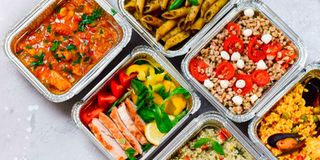Premium
High home inflation lifts food joints

Hungry customers grab an affordable meal at a food kiosk run by a vendor outside Chandarana Industries in Baba Dogo, Nairobi.
What you need to know:
- Rising cost of food items and cooking gas sends many city residents to eating joints where they can save a shilling or two.
- Delivery service firms have continued to record steady orders for takeaway foods from restaurants and food vendors.
For about two years, disruptions caused by Covid-19 pandemic hit restaurants hard. Stringent social distancing regulations by health authorities either meant partial or total closure of outlets, leaving entrepreneurs with strings of losses.
Some did not survive the turmoil while others turned to ingenuity including scaling down operations to cut costs until normalcy returned.
And just as matters began improving for restaurants following the lifting of Covid restrictions, a new crisis struck at the start of this year.
A rapid rise in the prices of food items and liquefied petroleum gas (LPG) put restaurants under new pressure — slowing down a projected rebound and darkening the outlook for thousands of investors who had hoped to thrive once again.
But in what has turned out a savior for restaurants the cost of eating at home has risen higher than sourcing food away from home -- forcing many Kenyans to stick with the restaurants.
According to data by the Kenya National Bureau of Statistics (KNBS), the average prices of food and non-alcoholic beverages at home increased by about 9.92 per cent in the year to March. The highest increase was registered in the price of cooking oil at 35.15 per cent, sukuma wiki (20.15), spinach (19.96), wheat flour (17.68), Irish potatoes (15.32), and carrots (10.72).
This was compounded by a sharp 38.18 per cent jump in the prices of LPG in the 12 months in March on global uncertainties. LPG is a popular cooking fuel among urban households.
Contrastingly, the cost of eating away from home in restaurants and accommodation facilities increased by about 1.48 per cent in the year to March — perhaps an indication that restaurants can deal with such increases by buying food stocks in bulk and or absorbing a portion of the cost in terms of reduced wages and the size of their workforce.
This has seen many Kenyans continuing to eat out of home or opt for takeaway orders.
Takeaway foods
“It makes sense to have takeaway food from the restaurant, especially for those living alone because the cost of cooking at home has become very high. Figure out the high-cost cooking oil and gas and you realise it would be better to eat out or buy ready-made food from a restaurant or café,” Jean Mainge, a Nairobi resident told Smart Business.
Delivery service firms have continued to record steady orders for takeaway foods from restaurants and food vendors.
Priscilla Muhiu, the general manager at Glovo Kenya says amid the rapidly rising inflation, food orders continue to rise, with the company registering 10 per cent month-on-month growth.
“Even with inflation, which has affected the prices of raw materials such as chicken, and food outlets factoring that in their pricing, consumers are still making orders,” she said.
“However, prices of food have not gone up significantly.”

Take out food.
Ms Muhiu said the delivery company saw a larger uptake of groceries during the pandemic amid restrictions of movement.
Grocery orders continue to rise recording 20 per cent month-on-month growth but ahead of food.
“Food orders are growing but at a slower rate than groceries,” she added.
Glovo alongside other online food delivery services including Bolt Food and Uber Eats gained prominence during the pandemic when restaurants leveraged them to make sales.
Fast food outlets
The platforms used to be the domain of established fast food outlets, local restaurants, cafes, and big hotels.
Change in customer preference has also helped push the app's operators to include informal restaurants, referred to as vibandas.
Ms Muhiu said vibandas amid the high cost of living, are serving as an alternative to consumers who are sensitive to the price change but still eating out.
With most companies resuming in-office work schedules, online orders have improved especially during lunch hours.
“We are giving customers options for their orders with dishes that are going from Sh200 to Sh250. People are still making orders. After all, they don’t have an option because everything has gone up,’’ she added.
With the high jump in food prices, some restaurant chains have not been able to avoid raising menu prices.
For instance, American fast-food chain KFC recently reviewed prices on its menu. It raised the price of its popular pack of two pieces of chicken and regular chips commonly referred to as streetwise two to Sh370 in December up from Sh350.
A survey across several city estates shows that small eateries have also made minor price adjustments on their food menus even though customers maintained orders of items such as potato chips and chapati.
“There has been noticeable improvement in demand because many are avoiding cooking at home due to the prices of many items have shot up substantially. Business is better for us than a few months ago,” Martin Mwangi who runs a small eatery in Nairobi’s Lang’ata estate says.





